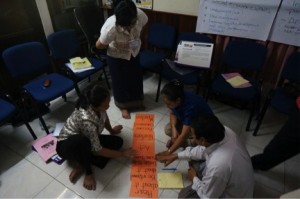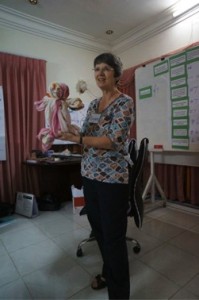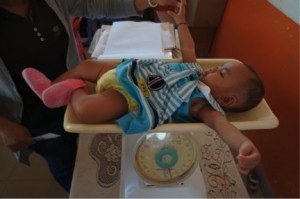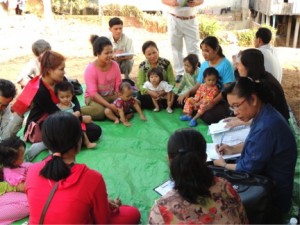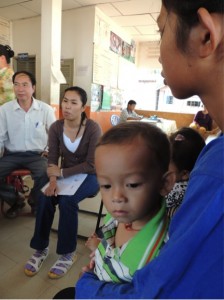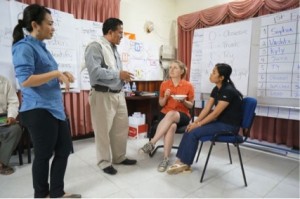A previous blog post gave an overview of the exciting and interactive Behaviour Change Communication workshop held at HKI in early February, 2013.
In this post, we talk about the daily activities covered in the workshop in more detail.
Day 1:
From the first moment of the training, we, the participants, were actively involved with the workshop material. We didn’t waste a moment getting started with ice breakers that had the whole team laughing. The pre-test to assess our knowledge was a series of 15 questions that we each answered with hand signals as we stood in a large group with our backs to one another.
Over the course of the day, we reviewed the eight Essential Nutrition Actions (ENAs) aimed at improving nutrition outcomes for mother and baby during the first 1000 days of life, from conception to 24 months, where the window of opportunity for positive impact is highest. Through interactive activities such as solving puzzles (seen above), team brainstorms, and case study demonstrations, we explored the contact points for health services, recommended Infant and Young Child Feeding (IYCF) practices, the Essential Hygiene Actions (EHA), women’s nutrition, the 3 food groups, and the sources and roles of iron, vitamin A, and iodide.
In small groups we worked together to identify the consequences of malnutrition for the baby, mother and family and then we discussed as a large group one impressive statistic we learned was that the risk of mortality for an undernourished baby is 14 times higher than for a well-nourished baby.
At the end of the day, we reviewed counseling skills and strategies for promoting behavior change and had the opportunity to build our counseling confidence by practicing reflective listening, asking open-ended questions, and offering support.
Day 2:
On day 2 of the workshop, a doll was quickly fashioned from a rolled up towel and elastic bands. The doll was used throughout the rest of the workshop to demonstrate and practice breastfeeding positioning. Techniques like these were often used to show how low-tech and low-cost teaching tools can be effective.
Over the course of the second day, as a group we identified and discussed the risks of not breastfeeding for mother and baby, the recommended breastfeeding practices, common breastfeeding difficulties and solutions, and breastfeeding myths. We were even taught how to express breast milk and identify a plugged milk duct!
Day 3:
The third day of the workshop was all about the recommended complementary feeding practices. Here you can see the final stage of a series of activities that had the group working together to determine the appropriate texture, frequency, amount and variety of food appropriate for babies from 6-8 months, 9-11 months and 12-24 months of age. The final stage of this activity was to make appropriate meals with some commonly available foods, seen below.
We learned that since the traditional Cambodian complementary foods are deficient in iron, it is important that animal foods are introduced to children starting at 6 months of age.
Another important component of the third day was practicing counseling skills to promote behavior change among parents. We practiced counseling parents, focusing on one or two important but small messages and working with them to develop small actions that they could implement over a two-four week period. The aim of this strategy was to support realistic change rather than stymieing the potential for change by overwhelming the parent. For example, instead of telling a mother to work on the frequency, amount, texture, and variety of foods when complementary feeding, we could encourage her to focus first on texture/consistency of the food she feeds her 7 month old baby, making porridge less watery, so as not to displace nutrients. During follow-up visits, additional changes, such as adding more variety can be discussed.
Day 4
On day 4, we conducted our first visit to a local health clinic on the outskirts of Phnom Penh to practice counseling skills with mothers of infants less than 6 months of age. Here you can see an infant being weighed as she plays with a workshop participant.
During out time at the health center counseling mothers, we used the “GALIDRAA” approach: Greet, Ask, Listen, Identify, Discuss, Recommend, Agree to Action, Appointment. For example, one student counseled a new mother (with a 1-hour old infant) on proper breastfeeding techniques. After building rapport and listening to her first breastfeeding experience, we identified that the new mother had difficulty with positioning and attachment. After working together, she practiced proper breastfeeding positioning and attachment and verbally repeated back what she learned.
Day 5:
On day 5, we visited the health clinic for a second time to host two groups of parents and children older than 6 months of age. One group was conducted as an action-oriented group, while the other was a support group. In the support group, the facilitator encouraged each mother to share her experiences, which is another way to share information and receive support from each other. Here you can see the support group discussing complementary feeding.
With the action-oriented group, we used a story to illustrate a problem and used “OTTA” to encourage participation; we asked the group to describe what they Observed when listening to the story, what they Thought about the story or problem and if they could relate the story to their lives, what the people in the story could Try to do about the problem and finally, what the Action should be to resolve the problem. Here you can see the facilitator telling the story to the ten mother-child pairs.
Day 6:
On the last day of the workshop, we were back in the office to debrief and learn a few more lessons. We reviewed feeding the sick child and infant feeding in the context of HIV. In Cambodia, the recommendation for an HIV-infected mother (not on anti-retroviral medications) is to express breast milk into a jar, and heat it in a pot of water until the water boils.
To conclude our training, we discussed the process of developing action plans: (1) Who, (2) Why, (3) Where, (4) When, (5) What, (6) What for, and (7) How. In groups, we worked on action plans for the FOF project and how we can apply the information learned during the previous 6-days.
At the very end of the day, we did a post-test and we all aced it! Overall, the training was packed with great information and helpful strategies for promoting behavior change.
By: Sophia Baker-French & Vashti Timmermans


